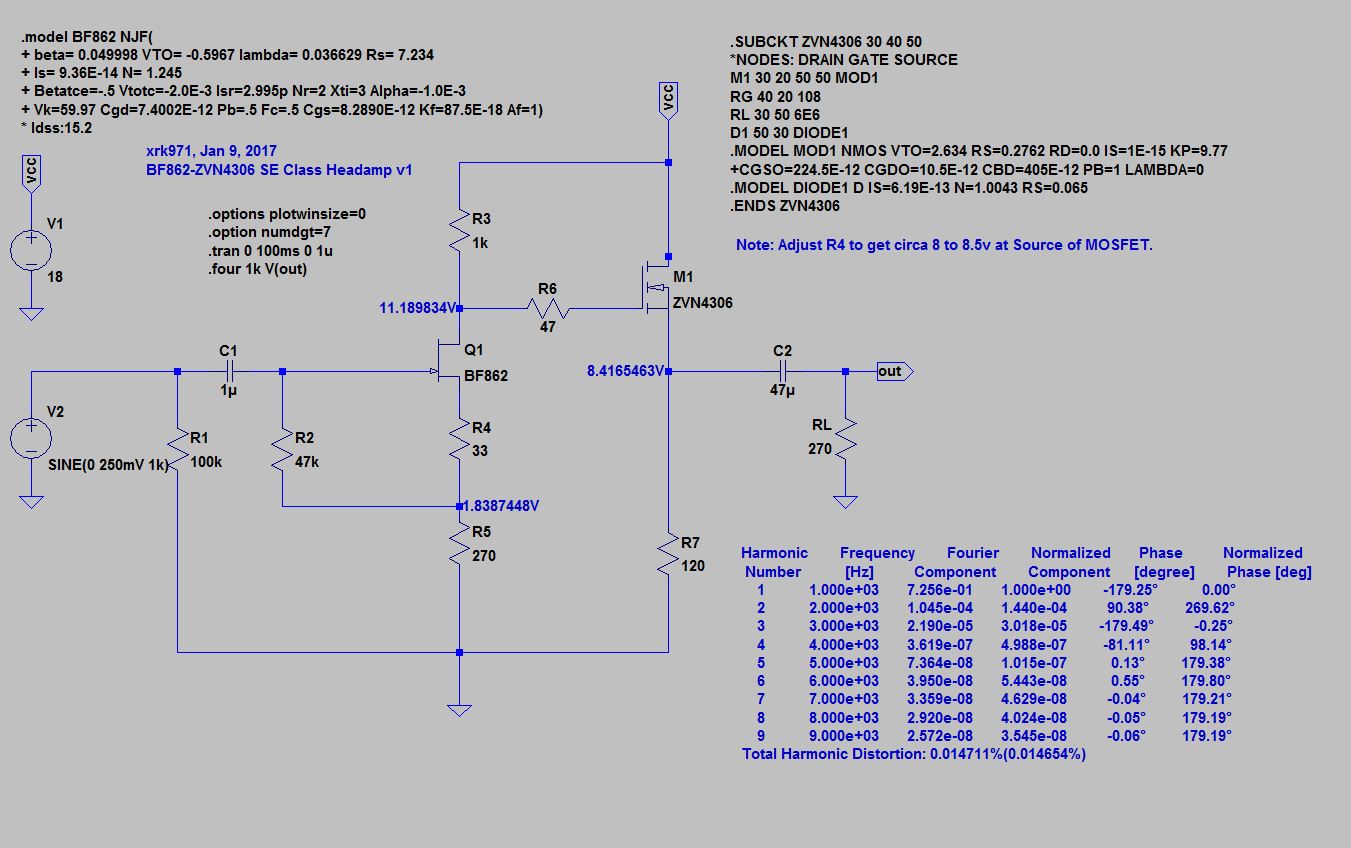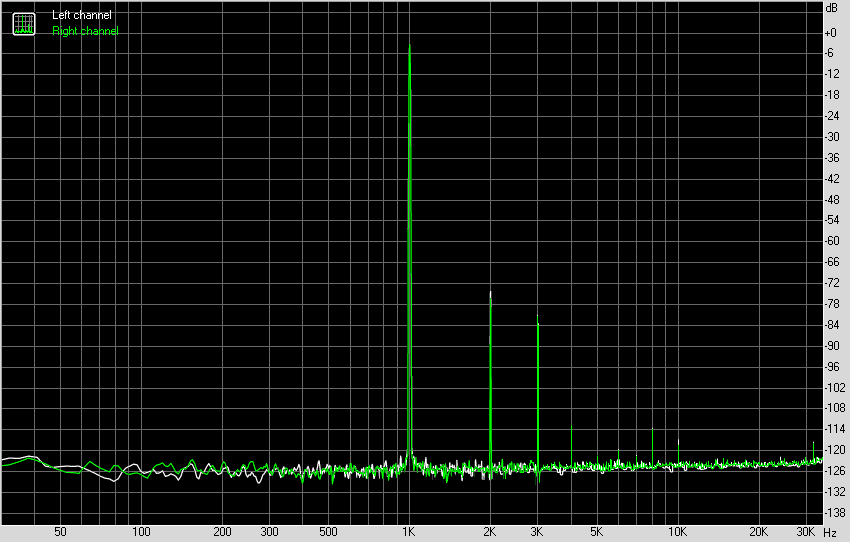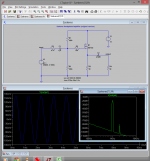I'd give the Szekeres a 1-transistor current source though, it tends to help linearity out a lot.
Adequate heatsinking for both the MOSFET and current source transistor is to be provided. (When using one heatsink for both, isolated mounting is required.) Standard bias for a Szekeres tends to be around 150 mA, for a relatively low-impedance headphone (Grados are 32 ohm jobs) I'd consider going higher than that... up to double.
Note that a follower like that should be run from a relatively low source impedance, so I suggest a 10k pot and no higher. The usual suggestions for input DC bias also tend to leave some room for improvement.
Adequate heatsinking for both the MOSFET and current source transistor is to be provided. (When using one heatsink for both, isolated mounting is required.) Standard bias for a Szekeres tends to be around 150 mA, for a relatively low-impedance headphone (Grados are 32 ohm jobs) I'd consider going higher than that... up to double.
Note that a follower like that should be run from a relatively low source impedance, so I suggest a 10k pot and no higher. The usual suggestions for input DC bias also tend to leave some room for improvement.
I'd give the Szekeres a 1-transistor current source though, it tends to help linearity out a lot.
Yep, a good plan. A simple CCS using a DN2540 with no source resistor would give ~350mA bias.
Seven resistors, two caps, two transistors and you will have beautiful sounding amp. Not kidding.

http://www.diyaudio.com/forums/group-buys/302859-xrk971-pocket-class-headamp-gb.html
It's a source follower. Ultra low noise floor of -126dB, 94dB dynamic range, flat frequency response from 15Hz to 35kHz. Superb harmonic profile. THD of around 0.015% to 0.06% depending on bias setting.
The one as built with data below uses 2.2uF input cap and 390uF output cap.
Measured FFT at 1kHz for 700mV into 270ohm load:


http://www.diyaudio.com/forums/group-buys/302859-xrk971-pocket-class-headamp-gb.html
It's a source follower. Ultra low noise floor of -126dB, 94dB dynamic range, flat frequency response from 15Hz to 35kHz. Superb harmonic profile. THD of around 0.015% to 0.06% depending on bias setting.
The one as built with data below uses 2.2uF input cap and 390uF output cap.
Measured FFT at 1kHz for 700mV into 270ohm load:

Superb harmonic profile. THD of around 0.015% to 0.06% depending on bias setting.
Measured FFT at 1kHz for 700mV into 270ohm load
But, his headphones are 32-ohm. How's the performance into that load?
Last edited:
A simulation with 270R load vs 29R load shows that the THD goes up a bit but with slight change of one resistor (R4) to next value higher gives excellent performance yet still. THD approximately doubled but with same profile of dominant H2 and H3 about -12dB less with not too much else. Some might argue it will sound even better. So the amp design is still within its range of operability with 30ohm cans by adjustment of one resistor.
Much appreciation for the responses! Yesterday was busy day.
I found these two useful links for determining headphone power needs.
Headphone Impedance - Head-Fi.org Community
Headphone & amp specs
Based on the later it looks like for 110db peaks
16mw of power
.71 volts
22 ma
pretty amazing.
The xrk971 looks great.
The simplest single fet version of the Szekeres is very tempting to use as a comparison truth box for anything else I build. Is C1 just to block input DC?
I found these two useful links for determining headphone power needs.
Headphone Impedance - Head-Fi.org Community
Headphone & amp specs
Based on the later it looks like for 110db peaks
16mw of power
.71 volts
22 ma
pretty amazing.
The xrk971 looks great.
The simplest single fet version of the Szekeres is very tempting to use as a comparison truth box for anything else I build. Is C1 just to block input DC?
Is C1 just to block input DC?
In both the Szekeres and xrk amps, the input capacitor is there since the gate of the input device sits at a positive voltage with respect to ground. So, yes, but probably for the opposite reason you had in mind (i.e. keeping DC from getting to the gate of the input device).
On my two transistor amps, the input and output caps are DC biased at about 2-4v on input and 8-12v on output. This biasing keeps the dielectric energized in a prestressed state and avoids crossover distortion since the cap voltage never crosses through zero volts. This means better sound quality. So in addition to DC blocking, they are also DC energized.
I have done some more research on this project on and off. And I built the Szekeres using STP11NK50ZFPs because thats what I happened to have, running them at various voltages from 200v to 12v and a variety of R4 values to listen to current from 30ma to 120ma or so. I havent decided on a sweet spot though. Overall it sounds much better than I expected! Quite enjoyable. I have a question.
>Standard bias for a Szekeres tends to be around 150 mA, for a relatively low-impedance headphone (Grados are 32 ohm jobs) I'd consider going higher than that... up to double.
For 110db peaks I calculate the Grados at 32 ohms and 98db efficiency should require .71 volts rms, something like 22ma or 31ma at idle (22 x 1.414).
Im using the spreadsheet I posted and the 1.414 multiplier for idle current I picked on here somewhere, cant find the reference at the moment. So my obvious question is why the suggestion to bias for 150ma or double? Im missing something I assume. Thanks in advance
>Standard bias for a Szekeres tends to be around 150 mA, for a relatively low-impedance headphone (Grados are 32 ohm jobs) I'd consider going higher than that... up to double.
For 110db peaks I calculate the Grados at 32 ohms and 98db efficiency should require .71 volts rms, something like 22ma or 31ma at idle (22 x 1.414).
Im using the spreadsheet I posted and the 1.414 multiplier for idle current I picked on here somewhere, cant find the reference at the moment. So my obvious question is why the suggestion to bias for 150ma or double? Im missing something I assume. Thanks in advance
1) To run LOUD and Never-Clip, you may (or may not!) want >120dB SPL. Which for 32r 98dB/mW is over 100mA.
2) Running just-enough current to cover your peaks means rising THD at high outputs. It is an old tradition on simple amplifiers to aim for Max power very significantly higher than any normal signal.
3) Because we can! In loudspeakers we need many-Watts and for simple resistor-loaded amplifiers (efficiency <6%) this leads to Room Heaters or modest power. But headphones are fine with 1/1000th as much power, so an "excessive" phone amp is only a hand-warmer, not a toaster-oven.
2) Running just-enough current to cover your peaks means rising THD at high outputs. It is an old tradition on simple amplifiers to aim for Max power very significantly higher than any normal signal.
3) Because we can! In loudspeakers we need many-Watts and for simple resistor-loaded amplifiers (efficiency <6%) this leads to Room Heaters or modest power. But headphones are fine with 1/1000th as much power, so an "excessive" phone amp is only a hand-warmer, not a toaster-oven.
PRR thanks for the response. Ok, seems reasonable. Especially point #2.
I guess my next question in the probably often repeated standard newbie list is: How do I get rid of the giant output cap and keep this simple SE circuit? I havent done the google searching on this yet but since im here replying to you I will post my thoughts. One is some kind of dc servo circuit, any recommendations? Im sure there are a million out there. The other and I suspect this will betray some basic misunderstanding on my part, is given how low the Zout is, a parafeed 1:1 output transformer which I have to figure out how low in inductance it could be and still give good bass at headphone amp wattage. Might a line level 600:600 or 1k:10k work in this application?
I guess my next question in the probably often repeated standard newbie list is: How do I get rid of the giant output cap and keep this simple SE circuit? I havent done the google searching on this yet but since im here replying to you I will post my thoughts. One is some kind of dc servo circuit, any recommendations? Im sure there are a million out there. The other and I suspect this will betray some basic misunderstanding on my part, is given how low the Zout is, a parafeed 1:1 output transformer which I have to figure out how low in inductance it could be and still give good bass at headphone amp wattage. Might a line level 600:600 or 1k:10k work in this application?
- Status
- This old topic is closed. If you want to reopen this topic, contact a moderator using the "Report Post" button.
- Home
- Amplifiers
- Headphone Systems
- Lowest parts count grado amp.
